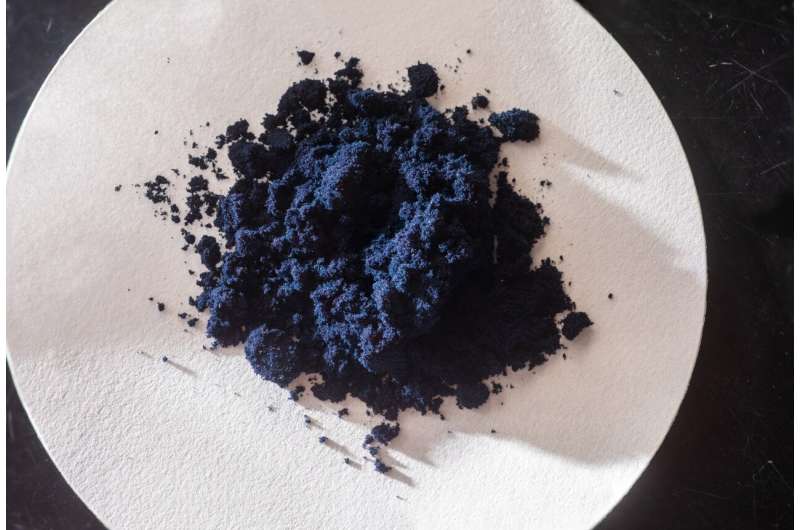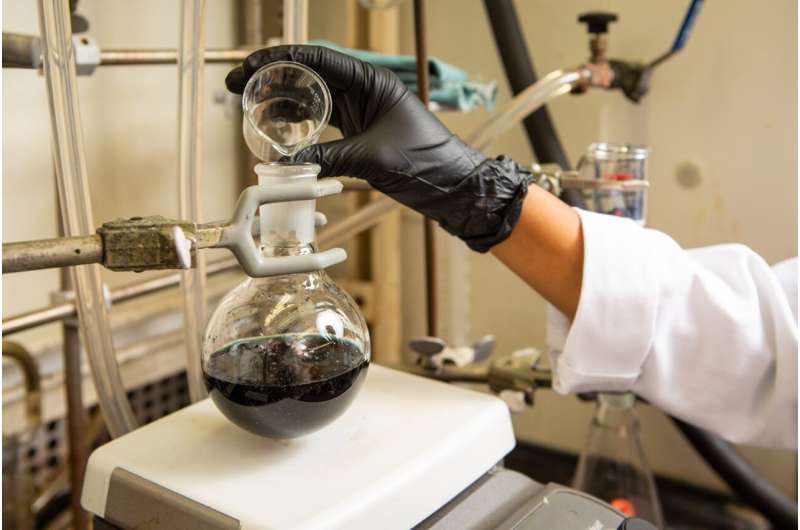Chemists stabilize hard-to-tame chloride compound

Molecular compounds containing chlorine atoms alongside another element are vital materials in chemical synthesis.
Called "binary chlorides," they can be used to help make other compounds with applications in fields including medicine, agriculture and materials research. But as University at Buffalo chemist David Lacy explains: "Some useful binary chlorides are unstable and essentially impossible to work with."
A new study by Lacy's team addresses this problem.
On Sept. 6 in the Journal of the American Chemical Society (JACS), the scientists report using a simple process to stabilize one unruly binary chloride molecule—manganese trichloride (MnCl3). The method involves fixing a stabilizing agent to MnCl3 that prevents it from indiscriminately shedding chlorine atoms, as it would normally do.
"We've discovered a convenient, new way to manipulate chlorine and manganese, which are two important elements in organic chemistry," says Lacy, Ph.D., associate professor of chemistry in the UB College of Arts and Sciences. "Everything can be done open-air with commercially available materials at room temperature, and it takes only a few hours. It's a one-step process. You mix four safe, inexpensive compounds together in one reaction, and the product just precipitates."
The stable molecule containing manganese trichloride could be employed to help synthesize industrial compounds such as pharmaceutical precursors, artificial enzymes and chemicals involved in biological processes like photosynthesis, according to Lacy, the study's senior author, and Ananya Saju, the first author and a UB Ph.D. student in chemistry.
"The stabilizing agent is easy to remove and is inexpensive," Lacy says. "This discovery opens the floodgates to a whole new area of research."
The stable compound containing manganese trichloride has the chemical formula MnCl3(OPPh3)2. The UB team discovered a way to create this molecule expediently while studying various stabilizing agents for a project funded by a National Science Foundation CAREER grant Lacy received.
"We were screening a number of stabilizing agents, and in one of those reactions, there was one blue complex that popped up and seemed to be very stable," Saju says.

That bench-stable complex was MnCl3(OPPh3)2, the subject of the new JACS article.
Soon after Saju created this molecule in the lab, study co-author Justin R. Griffiths, Ph.D., then a postdoctoral researcher in UB's chemistry department, came across a paper from 1976 where scientists reported creating MnCl3(OPPh3)2, among other compounds. But the method researchers used to prepare the complex in the 1970s was cumbersome, requiring temperatures well below freezing.
"We did not discover the molecule," Lacy says, "but we serendipitously rediscovered it" while using a much easier process to produce the compound. The team also demonstrated the utility of the complex in chemical synthesis, using MnCl3(OPPh3)2 to add chlorine atoms to alkenes, something the 1976 research did not explore.
More information: Ananya Saju et al, Synthesis of a Bench-Stable Manganese(III) Chloride Compound: Coordination Chemistry and Alkene Dichlorination, Journal of the American Chemical Society (2022). DOI: 10.1021/jacs.2c08509
Journal information: Journal of the American Chemical Society
Provided by University at Buffalo



















